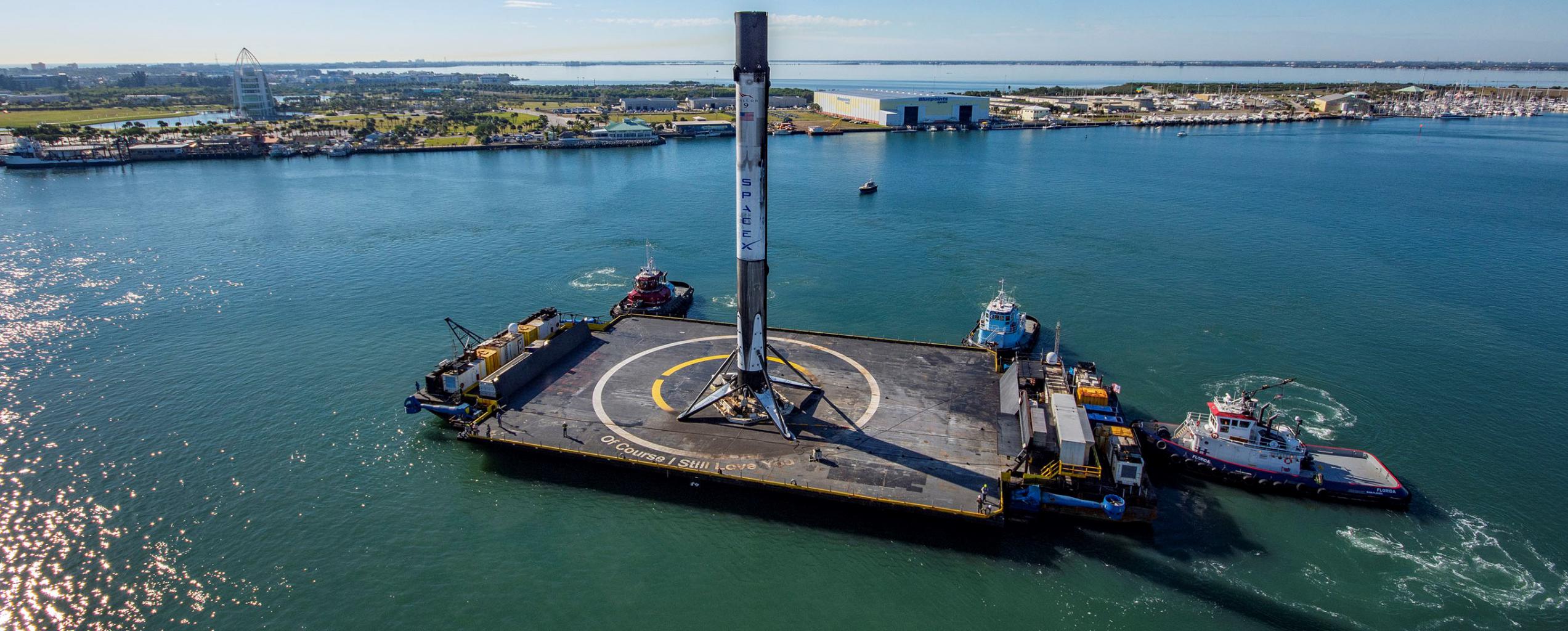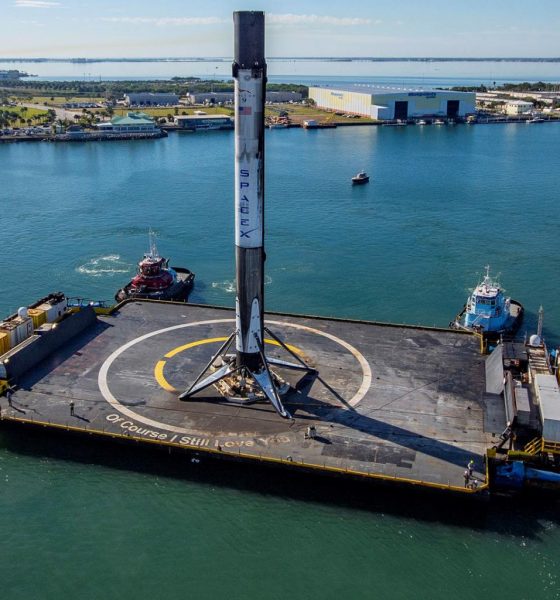

News
SpaceX eyes Starlink to connect rocket recovery ships to the internet
Regulatory filings show that SpaceX wants to use Starlink to connect its fleet of rocket recovery ships to the internet, potentially kicking off a range of tests that could prove the nascent satellite internet network viable for maritime use.
First reported by CNBC, the news came in the form of a radio service application filed with the US Federal Communications Commission (FCC) on September 15th. Such filings are routine, at this point, as SpaceX works to dramatically expand the network of fixed ground stations that will serve as network hubs for all Starlink internet services. Done through subsidiaries Space Exploration Holdings LLC and SpaceX Services Inc, SpaceX has filed for more than 500 experimental licenses, Earth station licenses, and Special Temporary Authority (STA; permission to temporary communicate without a dedicated license) in just the last 12 months.
Hundreds of those filings represent licenses for several hundred ground stations in the US alone, with several more dedicated to the increasingly widespread use of user terminals – smaller antennas meant for individual buildings. SpaceX’s September 15th application, however, requests permission to install several user terminals on an active fleet of rocket recovery ships – possibly the company’s first attempt to license Starlink communication with mobile users.

For SpaceX itself, flexible and responsive communications services from a low Earth orbit (LEO) satellite constellation is highly desirable. The company currently relies on off-the-shelf parabolic antennas and traditional geostationary satellite internet providers to connect a fleet of at least seven active ships used to recover Falcon boosters, Falcon fairings, and Dragon spacecraft.
For the broader Starlink business, maritime communications represent a fixed, largely captive market worth at least $1.3 billion annually in 2019, while the industry estimates growth to at least ~$2.4 billion per year by the end of the decade. The massive bandwidth, unprecedentedly low latency, and low costs it aims to offer means that Starlink is exceptionally positioned to disrupt the maritime communications market, much like it could quickly become a huge figure in the in-flight connectivity industry.
Near-term, the addition of Starlink user terminals on SpaceX rocket recovery ships could potentially mean that those ships could broadcast the live views they bring to SpaceX webcasts over SpaceX’s own satellite network. Starlink terminals are likely too large to feasibly fit on Falcon rockets themselves. However, it’s possible that the use of cutting-edge phased-array antennas and the ability to literally tailor Starlink network performance to fit SpaceX’s needs could potentially allow for much higher-quality live footage in SpaceX webcasts, possibly even solving the issue of satellite network connection instability during Falcon booster drone ship landings.
There would be a certain satisfying symmetry if Starlink ensured even better live views of the Falcon booster landings that effectively made the unprecedented satellite constellation possible in the first place.
Check out Teslarati’s Marketplace! We offer Tesla accessories, including for the Tesla Cybertruck and Tesla Model 3.

News
Tesla FSD fleet is nearing 7 billion total miles, including 2.5 billion city miles
As can be seen on Tesla’s official FSD webpage, vehicles equipped with the system have now navigated over 6.99 billion miles.

Tesla’s Full Self-Driving (Supervised) fleet is closing in on almost 7 billion total miles driven, as per data posted by the company on its official FSD webpage.
These figures hint at the massive scale of data fueling Tesla’s rapid FSD improvements, which have been quite notable as of late.
FSD mileage milestones
As can be seen on Tesla’s official FSD webpage, vehicles equipped with the system have now navigated over 6.99 billion miles. Tesla owner and avid FSD tester Whole Mars Catalog also shared a screenshot indicating that from the nearly 7 billion miles traveled by the FSD fleet, more than 2.5 billion miles were driven inside cities.
City miles are particularly valuable for complex urban scenarios like unprotected turns, pedestrian interactions, and traffic lights. This is also the difference-maker for FSD, as only complex solutions, such as Waymo’s self-driving taxis, operate similarly on inner-city streets. And even then, incidents such as the San Francisco blackouts have proven challenging for sensor-rich vehicles like Waymos.
Tesla’s data edge
Tesla has a number of advantages in the autonomous vehicle sector, one of which is the size of its fleet and the number of vehicles training FSD on real-world roads. Tesla’s nearly 7 billion FSD miles then allow the company to roll out updates that make its vehicles behave like they are being driven by experienced drivers, even if they are operating on their own.
So notable are Tesla’s improvements to FSD that NVIDIA Director of Robotics Jim Fan, after experiencing FSD v14, noted that the system is the first AI that passes what he described as a “Physical Turing Test.”
“Despite knowing exactly how robot learning works, I still find it magical watching the steering wheel turn by itself. First it feels surreal, next it becomes routine. Then, like the smartphone, taking it away actively hurts. This is how humanity gets rewired and glued to god-like technologies,” Fan wrote in a post on X.
News
Tesla starts showing how FSD will change lives in Europe
Local officials tested the system on narrow country roads and were impressed by FSD’s smooth, human-like driving, with some calling the service a game-changer for everyday life in areas that are far from urban centers.

Tesla has launched Europe’s first public shuttle service using Full Self-Driving (Supervised) in the rural Eifelkreis Bitburg-Prüm region of Germany, demonstrating how the technology can restore independence and mobility for people who struggle with limited transport options.
Local officials tested the system on narrow country roads and were impressed by FSD’s smooth, human-like driving, with some calling the service a game-changer for everyday life in areas that are far from urban centers.
Officials see real impact on rural residents
Arzfeld Mayor Johannes Kuhl and District Administrator Andreas Kruppert personally tested the Tesla shuttle service. This allowed them to see just how well FSD navigated winding lanes and rural roads confidently. Kruppert said, “Autonomous driving sounds like science fiction to many, but we simply see here that it works totally well in rural regions too.” Kuhl, for his part, also noted that FSD “feels like a very experienced driver.”
The pilot complements the area’s “Citizen Bus” program, which provides on-demand rides for elderly residents who can no longer drive themselves. Tesla Europe shared a video of a demonstration of the service, highlighting how FSD gives people their freedom back, even in places where public transport is not as prevalent.
What the Ministry for Economic Affairs and Transport says
Rhineland-Palatinate’s Minister Daniela Schmitt supported the project, praising the collaboration that made this “first of its kind in Europe” possible. As per the ministry, the rural rollout for the service shows FSD’s potential beyond major cities, and it delivers tangible benefits like grocery runs, doctor visits, and social connections for isolated residents.
“Reliable and flexible mobility is especially vital in rural areas. With the launch of a shuttle service using self-driving vehicles (FSD supervised) by Tesla in the Eifelkreis Bitburg-Prüm, an innovative pilot project is now getting underway that complements local community bus services. It is the first project of its kind in Europe.
“The result is a real gain for rural mobility: greater accessibility, more flexibility and tangible benefits for everyday life. A strong signal for innovation, cooperation and future-oriented mobility beyond urban centers,” the ministry wrote in a LinkedIn post.
News
Tesla China quietly posts Robotaxi-related job listing
Tesla China is currently seeking a Low Voltage Electrical Engineer to work on circuit board design for the company’s autonomous vehicles.

Tesla has posted a new job listing in Shanghai explicitly tied to its Robotaxi program, fueling speculation that the company is preparing to launch its dedicated autonomous ride-hailing service in China.
As noted in the listing, Tesla China is currently seeking a Low Voltage Electrical Engineer to work on circuit board design for the company’s autonomous vehicles.
Robotaxi-specific role
The listing, which was shared on social media platform X by industry watcher @tslaming, suggested that Tesla China is looking to fill the role urgently. The job listing itself specifically mentions that the person hired for the role will be working on the Low Voltage Hardware team, which would design the circuit boards that would serve as the nervous system of the Robotaxi.
Key tasks for the role, as indicated in the job listing, include collaboration with PCB layout, firmware, mechanical, program management, and validation teams, among other responsibilities. The role is based in Shanghai.
China Robotaxi launch
China represents a massive potential market for robotaxis, with its dense urban centers and supportive policies in select cities. Tesla has limited permission to roll out FSD in the country, though despite this, its vehicles have been hailed as among the best in the market when it comes to autonomous features. So far, at least, it appears that China supports Tesla’s FSD and Robotaxi rollout.
This was hinted at in November, when Tesla brought the Cybercab to the 8th China International Import Expo (CIIE) in Shanghai, marking the first time that the autonomous two-seater was brought to the Asia-Pacific region. The vehicle, despite not having a release date in China, received a significant amount of interest among the event’s attendees.








